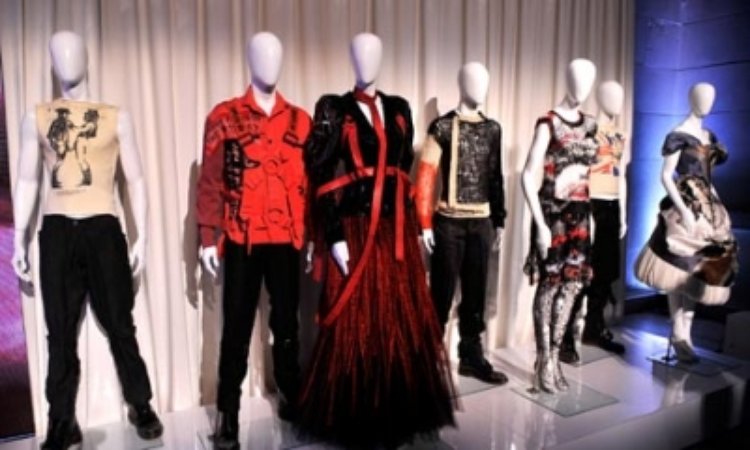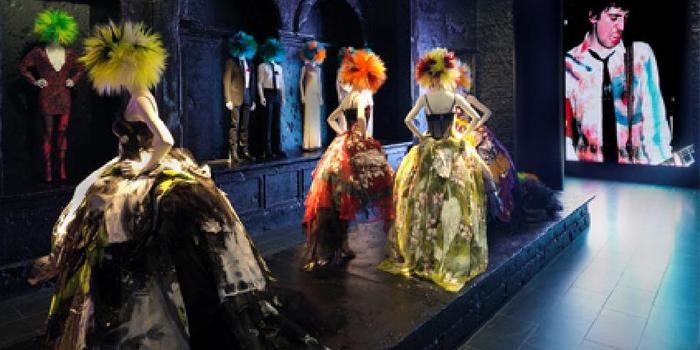Just a few weeks ago, the Costume Institute at the Metropolitan Museum of Art opened the doors to its annual fashion exhibition, this year taking on the theme of punk. “PUNK: Chaos to Couture”launched with much fanfare in the form of the Met Gala—often described as the Oscar’s for the fashion set—though the press seemed more concerned with what gala attendees (who included Beyoncé Knowles, Madonna, Gwyneth Paltrow, and, of course, Marina Abramovic) would be wearing on the red carpet than with the garments draping the mannequins inside the museum.

Looks from the "PUNK: Chaos to Couture" exhibition at the Met. Courtesy: Getty Images
Though fashion exhibitions now seem to be a staple of major museums’ programming, it was not until the 1980s that fashion took a stand as a legitimized fine art form. The exhibition that kick-started it all was the Metropolitan Museum of Art’s 1983-84 Yves Saint Laurent retrospective curated by former Vogue editor Diana Vreeland, a groundbreaking endeavor presenting current fashion rather than historic costume. Vreeland’s famous exhibitions during her tenure at the Costume Institute succeeded in abolishing the aura of antiquarianism previously associated with costume display and became the most influential examples of an emergent genre. The Saint Laurent retrospective was not without its critics, however, specifically because it was devoted to a living designer and appeared too closely tied to the commercial interests of the design house. A 1999 retrospective of designer Giorgio Armani at the Guggenheim Museum in New York sparked greater outrage in the media for similar reasons: a $15 million donation to the museum by the brand “seemed to suggest that the museum itself was for sale,” stated Patricia Bickers in an Art Monthly article, and raised questions about institutional ethics. Many critics at the time also believed the show to be curatorially compromised since the show primarily emphasized the designer’s recent work.

Yves Saint Laurent's infamous "Mondrian" dress. Image courtesy of the Met.
Resistance to fashion in art museums continues today: as Valerie Steele, a prominent fashion historian and the director of the Museum at the Fashion Institute of Technology has argued, the place of fashion within the museum “replicates the traditionally low status of fashion within academia.” Critics aside, renowned museums since the 1990s have become advocates of a natural overlap between art and fashion, an existence that has become an unavoidable part of our contemporary visual culture. Markus Brüderlin, Director of the Kunstmuseum Wolfsburg in Germany, has argued that “a museum pointing the way ahead in the search for Modernism in the twenty first century cannot ignore fashion,” and that fashion in museums is necessary “to provide [visitors] with the measure of otherness they deserve as a statement about our culture.” The Kunstmuseum Wolfsburg, along with other distinguished institutions such as The Metropolitan Museum of Art in New York, The Musée de la Mode et du Textile at the Louvre in Paris, and the Victoria and Albert Museum in London, have ardently supported fashion’s importance within visual culture and have accordingly, presented numerous landmark exhibitions devoted to fashion.
Another example of this proactive effort on the part of the museum to promote fashion within the arc of contemporary art was MOVE!, a two-day event at MoMA PS1 in the fall of 2010 featuring a series of collaborative performances and temporary installations created by fourteen fashion designer and artist pairs. Curated by Cecilia Dean, founder of Visionaire Magazine, and David Coleman, the NYTimes Style writer, the museum championed the mash-ups between art and fashion, and many of the participating designers and artists—including Rob Pruitt and Marc Jacobs, Terence Kohand Italo Zucchelli of Calvin Klein, Olaf Breuningand Cynthia Rowley, and Rashaad Newsome and Alexander Wang—were most excited about the opportunity to collaborate.

Olaf Breuning pours paint onto models clad in Cynthia Rowley clothing as part of a MoMA PS1 Move! performance
With this kind of institutional support, the fashion exhibition has evolved into what we know today: the blockbuster-like shows à la “Alexander McQueen: Savage Beauty” at the Costume Institute in 2011, which attracted a record-breaking 660,000+ visitors, making it the eighth biggest show on record at the Metropolitan Museum of Art. While it may be impossible for another museum to mount a fashion exhibition rivaling that of the McQueen retrospective, there is no doubt many will try.
























